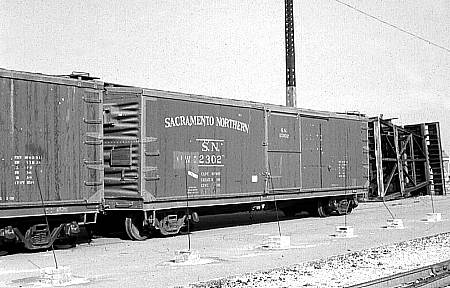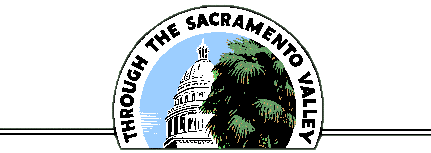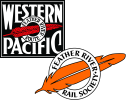SN MAINTENANCE OF WAY EQUIPMENT
The Northern Electric Railway began service with a small collection of odd freight cars inherited from the line's contractors, or purchased used from equipment brokers, many dating from around 1890 or earlier. Most of these early cars were used in construction work, though some certainly saw limited freight service. With the arrival of the Fitzhugh-Luther flatcars and boxcars in 1907, most of the older cars were relegated exclusively to maintenance service. All older cars were off the revenue roster by the 1916 PUC valuation.
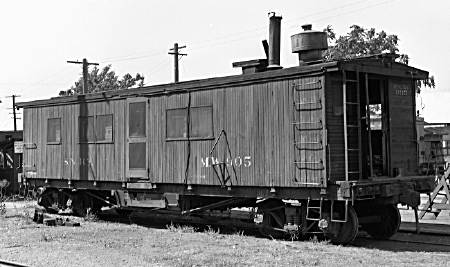
Among the early maintenance cars were boxcars in the 603-630 series. This group was purchased from N.B. Livermore in 1908. Some are known to have come from the Southern Pacific and dated from around 1890, though most cars from this series are not yet individually identified. One such car, possibly 619, may be seen coupled to motor 1010 on page 39 of Swett's CARS OF SACRAMENTO NORTHERN. The car had broad steps immediately below the door and a ladder to the left, classic maintenance duty features. Several cars in this series were probably rebuilt to other uses. These likely included caboose 623, which may have used parts from a boxcar of the same number, and possibly also cabooses 603 and 604, though their origin is not known for certain. Livermore also sold the NERY a group of flatcars numbered 400-426. Bunk cars 1000-1005 were rebuilt in 1914 from cars in this series, though again their original numbers are not known. Separate records have not been found for the majority of cars in these two groups.
The Pennsylvania Railroad sold the NERY at least two 50' wooden coaches, and a matching baggage car in 1907. The coaches were almost immediately converted to bunk cars 353 and 354. The baggage car was numbered 90 and logically used as a trailer for baggage, express and milk shipments. In 1912 it became a traveling demonstration car for Pacific Gas & Electric Co. to promote rural electrification. Later the car was converted to a maintenance car, probably around the line's 1918 reorganization as the Sacramento Northern Railroad.
Almost from their delivery, the Fitzhugh-Luther flatcars provided the materials to build many specialized cars, including freight motors, substation or transformer cars, and maintenance cars. As early as 1912, Fitzhugh-Luther flatcars were being converted to tool and bunk cars. Some cars from this series retained their original numbers after conversion, probably until the line was reorganized in 1918.
The 1916 California PUC valuation lists 64 cars in company service, many clearly hold-overs from construction days. These included the usual collection of bunk and dining cars, various un-described "outfit cars" which probably included both boxcars and flatcars for tools and supplies, 15 flatcars, a water tank car, and a tower car. There were also a ballast plow, and a pile driver. The valuation also mentions a recently scrapped Marion steam shovel. Ira Swett shows a photo of an annoyingly unnumbered derrick on page 47 of his CARS OF SACRAMENTO NORTHERN. Many cars dated from 1890, and quite a few had a pitiful 30,000 pound capacity. These were clearly not state-of-the-art, even for 1916. The line also owned fifty Rodger ballast cars. These were mainly used in company service, but were listed as revenue cars in the Official Railway Equipment Register, and so will not be discussed here.
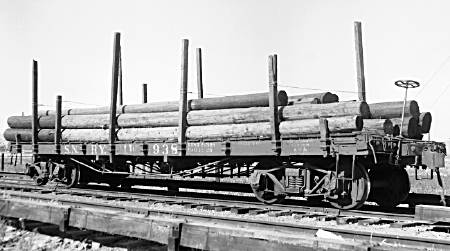
There did not appear to be any serious attempt to group NERY maintenance cars into one numerical series. Maintenance cars were scattered in the 300, 400, 600, 700, 800 and 1000 blocks. Under SNRR ownership, maintenance cars were more rationally renumbered into the 900 series.
The SNRR and early SNRY cleared out nearly all the NERY relics well before the 1929 merger. The 1928 ICC valuation working papers list only 20 cars left in company service, although the published valuation sets the number at 30. The most specialized cars were a pile driver and tender, and an air compressor car. The much smaller fleet was numbered 902-927.
Very little is known about the Oakland, Antioch & Eastern's construction fleet. The earliest records, notes by Vernon Sappers from a 1913 valuation, show but a few maintenance cars: a Brownhoist locomotive crane, a second Brownhoist crane (probably not self-powered), a steam-powered boom crane on a flatcar, a rail bonding car, a Marion steam shovel, and a locomotive tender, possibly attached to one of the cranes or the steam shovel. Sappers' notes also state that ten boxcars were used in maintenance service. Bunk cars MW 25, 26 and 29 are known to originally have been ex-SP cars, which suggests that other cars were purchased used for maintenance duty. Other cars needed for maintenance work, such as flatcars, were likely drawn ad-hoc from the revenue fleet, since there is no record of any flatcars dedicated to maintenance service at that early date. Records also note that there were two unnumbered flatcars on the line in 1928, though their origin and use is unknown. The early fleet also included up to 16 ballast cars. These were, however, listed in the Official Railway Equipment Register as revenue cars, and are not considered in this article.
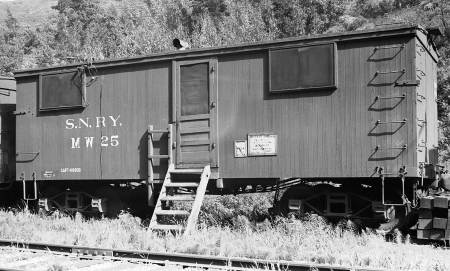
It is apparent that many of the former OA&E/SF-S cars were in very poor condition at the time of the merger. Several converted to maintenance service in 1929 were scrapped in the general house cleaning of 1934. It is likely that several OA&E/SF-S cars were replaced with NERY/SNRR cars in better condition using the same numbers. Recent research has disclosed an odd renumbering which explains one of these discrepancies. OA&E/SF-S 3001, later MW 40, was reported grounded at Walnut Creek as early as 1928. Other records show this car scrapped at Sacramento in 1955. There were apparently two cars with this number. Second MW 40 was ex-NERY/SNRR 2029, renumbered in 1935 at East Gridley. This case suggests that other OA&E/SF-S cars with retirement date conflicts in the records were actually scrapped in the 1930s, and their numbers recycled to better cars.
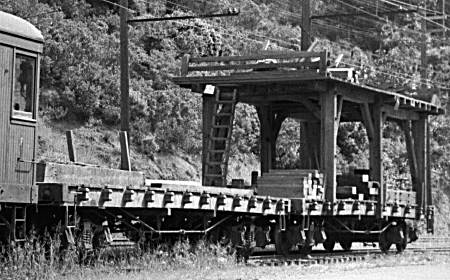
The SF-S apparently began the policy of adding "MW" before maintenance car numbers by the mid-1920s. This practice was continued by the post-merger SNRY in 1929 and was followed until the last dedicated SNRY maintenance cars were retired in the early 1970s.
The post-merger roster continued to have two separate maintenance series. Cars with the two-digit numbers were those inherited from the SF-S (probably up to around MW 37). The best of the remaining SF-S revenue cars were added to this group between 1929 and 1932, ending with MW 65. These generally served south of Sacramento on old OA&E lines.
Cars numbered MW 902 and above were those inherited from the pre-merger SNRR/SNRY. They were used north of Sacramento, and on the Holland and Vacaville-Willota Branches. Separation the two fleets was not followed perfectly, but it was generally true that former OA&E/SF-S cars stayed south of Sacramento, and former NERY/SNRR cars were kept on the northern half of the system until the 1950s.
Beginning in 1937 with the purchase of tank cars MW 66-68, a single numbering system was used for maintenance cars added to the fleet, regardless of assignment. The one exception was tool car MW 942 added in 1940, though this may have had been because the car was a rebuild of existing car MW 924.
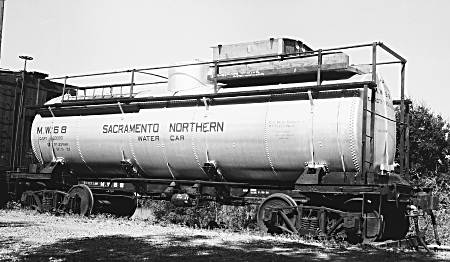
Of special interest are the SN's three 7,500 gallon water tanks, MW 66-68. These were purchased used in 1937 from an unknown source. At first glance, they are similar to American Car & Foundry Type IV tanks built around 1910. According to tank car expert Ed Kaminski, no tanks of this capacity were built by AC&F, so the SN tanks were likely knock-offs. Although they probably had other uses, the tanks were often used for fire control on weed burner trains. At least two had large boxes next to their domes to protect water hoses and valves, and possibly gasoline-powered pumps.
Until the end of passenger service in 1941, the SN did not use powered service equipment. Three former OA&E motors, combine 1009 and coaches 1019 and 1020, were retained as maintenance cars after 1941. They became MW 300-302 respectively. After the North End was dieselized in 1946, MW 300 and MW 301 were no longer needed as power cars and were demotorized. They became kitchen car MW 80 and dormitory MW 81 in 1947. MW 81 is preserved at the Western Railway Museum in unrestored condition. MW 302 continued to serve as a powered car on the south end until her electrical equipment burned up in 1955. The now-demotorized car was not renumbered. She is also preserved at the WRM, now restored as non-powered coach OA&E 1020.
By the 1950s, nearly all the former OA&E/SF-S cars had been scrapped, or in some cases grounded as sheds at Walnut Creek, Concord or West Sacramento. The last were burned for their metal at Moraga in 1957 or Port Chicago around 1960, or were dismantled at Concord. They were replaced by former SNRR/SNRY cars such as boxcar MW 02310 and flatcar MW 01449. The last surviving O&A/SF-S maintenance car is MW 32, preserved and restored by the California State Railway Museum as O&E 2002.
Excepting a few flatcars, early all the remaining wood-underframe freight cars not sold for scrap were converted to maintenance service in the years after World War II, particularly in 1947 and 1954. Special cars, like tower cars, pole flats, and tool cars assigned to the line gang, were scrapped as the wires came down or the third rail was lifted. Several 40-foot boxcars from the 2301- and 2329-series became maintenance cars by the early 1950s. There was another mass conversion in 1964 when the few remaining wooden flatcars, and nearly all the surviving 2301- and 2329-series boxcars, were reassigned to maintenance duty.
The last car renumbered into the old maintenance series was flatcar MW 94 in 1954. After that year, all cars converted simply had "MW 0" [zero] crudely painted before their original numbers. Many SN maintenance cars disappeared in the 1960s, replaced by cars borrowed from the Western Pacific. Some 2301 and 2329-series boxcars remained as tool or supply cars into the 1970s, with the last retired in 1976.
